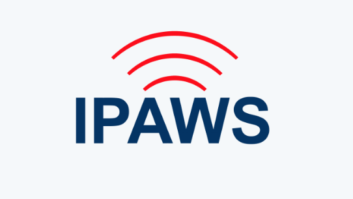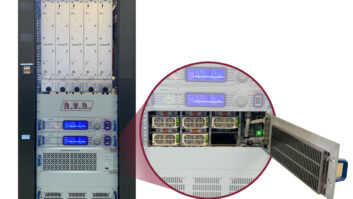
With some anticipation, public radio engineers all over the United States have been waiting for the next-generation satellite distribution system. New equipment was last deployed by the Public Radio Satellite System in 2011. The new generation will add important features to improve reliability and flexibility of program distribution, including a backup path via the public internet and new ways to manage individual station schedules via the ContentDepot web portal.
I asked Michael Beach, vice president of NPR Distribution, for details about the new system and the timetable for its deployment.
CHRISTMAS IN SUMMER
The first steps are underway. “There are parts of the new system that have already been shipped and received,” Beach told me via email (check out Figs. 1–3 for views of the initial equipment installations).
The initial development “environment,” consisting of uplink equipment and a set of test receivers, is in place in Washington. It will be followed by a stage environment that prepares for the delivery of the final live environment installations in the Washington Network Operations Center and the Backup Network Operations Center in St. Paul, Minn.
These preparations should be completed by early summer. A period of beta testing within the system should begin at this point, with selected stations installing equipment and dual operation of the existing system and the new generation of uplink services.
Receiver manufacturer ATX will begin shipping new equipment to individual stations in October, in staggered shipments. All affiliates are expected to have new receivers in hand by the end of 2019.
WHAT TO EXPECT
Each affiliate satellite-connected station will receive two new receivers, each with four stereo audio output ports. Stations not connected by satellite will have only one unit.
These new units (Fig. 4) will be a direct replacement for their existing equipment. An adapter will be provided to minimize wiring changes as the new equipment is installed in place of the old. The hardware process at the station level essentially involves pulling out the old receiver, bolting the new one in its place and plugging in the wires.
The new features and capabilities of the system will become available via the ContentDepot portal, where a new set of “broadcast services” will be introduced.
“When stations are ready to begin using the new receivers, they will need to associate the XDS ports with the broadcast services,” Beach said. “To take full advantage of the new XDS features, stations will want to clean up subscription data and update delivery preferences in the ContentDepot portal.”
[FCC’s C Band Plan Worries Broadcasters]
There is good news in this regard: It will not be necessary to go through the labor of re-subscribing to every desired program in a station’s schedule.
“We have upgraded the ContentDepot portal to enable ‘Broadcast Services’ on the current IDC receivers as well as the new XDS receivers to make it easier on the stations,” said Beach. The Broadcast Services will be enabled for the existing IDC receivers as well as the new ones from ATX. This will ease the period of dual-operations for affiliate stations and their engineers.
There will be some time for stations to familiarize themselves with the new options. Dual operations will continue until March 31, 2020, at least three months after everyone has received their equipment; stations are expected to have their new receivers installed by this date. Broadcast services will be released in the portal by October of this year, and PRSS will provide documentation and training in advance of receiver shipments. Final transition to the new distribution system and the end of dual operations will occur May 31, 2020.
INSIDE THE BOX
One of the most important features in the new ATX receiver is the addition of a network port that stations can use to connect it to the public internet.
“The goal is to be a hybrid satellite/terrestrial system, and to do that, we need a broadband connection to the receiver. If you want to take advantage of the features, you need an internet connection to it,” said Beach. Some kind of protective firewall will need to be installed between the receiver and its public internet connection to prevent unauthorized access to the receiver.
By connecting to the public internet, the receiver will have a backup path available to continue operation in the event there is a satellite failure, such as the twice-yearly solar alignments. During a solar alignment, the rotation of the earth is such that the desired satellite is exactly aligned with the sun as seen from the downlink dish. The high electromagnetic energy emitted from the sun overwhelms the downlink receiver with noise and causes a loss of data for up to 20 minutes. During these solar outages, receivers will detect when a program dropout occurs, and can continue to operate by substituting delivery of a scheduled satellite program with the same program delivered over the public internet.
Additionally, the internet connection can be used to monitor the health and telemetry of the receiver from the headend and/or by the individual station user. PRSS will be able to see the RF metrics for every station in the system as a means of assisting stations with troubleshooting problems at individual downlinks.
SPECIAL DELIVERY
There are other capabilities of the distribution system that will be enabled by the advanced receivers.
“Out of the gate, the most exciting feature is that stations will be able to put their ContentDepot live and file programming on a single output port on the receiver. This will allow a station to playout directly from the receiver without having switch between systems,” said Beach. No need to download the file from the receiver to an automation playout system. Program file store, forward and playback functions will be subscribed using the ContentDepot portal.
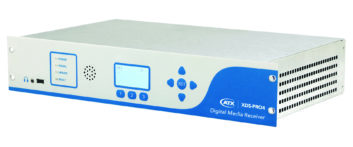
The automation capabilities of the system may entice some stations to shift away from their local delivery systems, although this would likely only be in situations where simple automation is required.
“We envision down the road that a station may be able to retire their automation system should they elect to,” said Beach. “For simple applications, this could act like an automation system, but if a station is doing complex operations, they’ll want to keep their current automation system.”
One other feature long requested by public radio engineers in northern climes appears to be on the verge of becoming a reality: a local indicator alarm for when the downlink has failed due to snow accumulation in the dish. “Yes, that is a feature that we are working on with the vendor,” said Beach. This will be a popular improvement.
TECH EXPERTS
To get the manufacturer’s perspective on the new system, I also contacted Jose Rivero, GM and chief technology and strategy officer for media broadcast at ATX Networks, a tech supplier to cable and satellite operators, enterprises and radio networks. The company says its XDS content management, distribution and monitoring products are deployed at 70% of U.S. radio networks as well as some of the biggest international ones; large customers include WestwoodOne, iHeartMedia, BBC, ESPN and Multivision.
According to Rivero, aspects of the new-generation system are unique to NPR and represent ground-breaking technology in the field of broadcast distribution.
“One collaboration is an enhanced receiver with the capability to store large quantities of prerecorded content and to reliably output via analog, AES3 and AES67 simultaneously,” said Rivero.
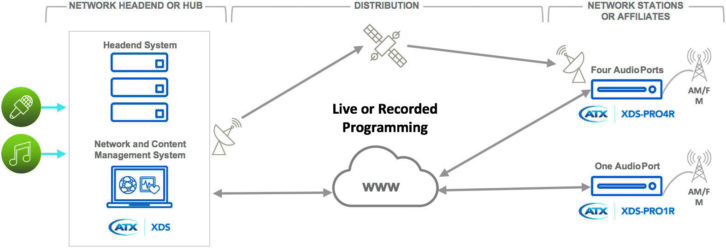
“Another is more robust and reliable live and pre-recorded audio distribution over satellite and internet, with a verification IP back channel to the PRSS NOC to track all aspects of the content playout, distribution and overall health of network. Also, the new XDS enhanced programming management and playout scheduling interface will be tightly integrated with ContentDepot, making it is easier for the stations to manage their programming.
“Some of these features and functions will be integrated into the commercially available product offered to all radio networks sometime in the future.”
Michael LeClair, CPBE, is manager of broadcast systems for WBUR Boston University and former tech editor of Radio World Engineering Extra.
Comment on this or any story. Email [email protected] with “Letter to the Editor” in the subject field.






